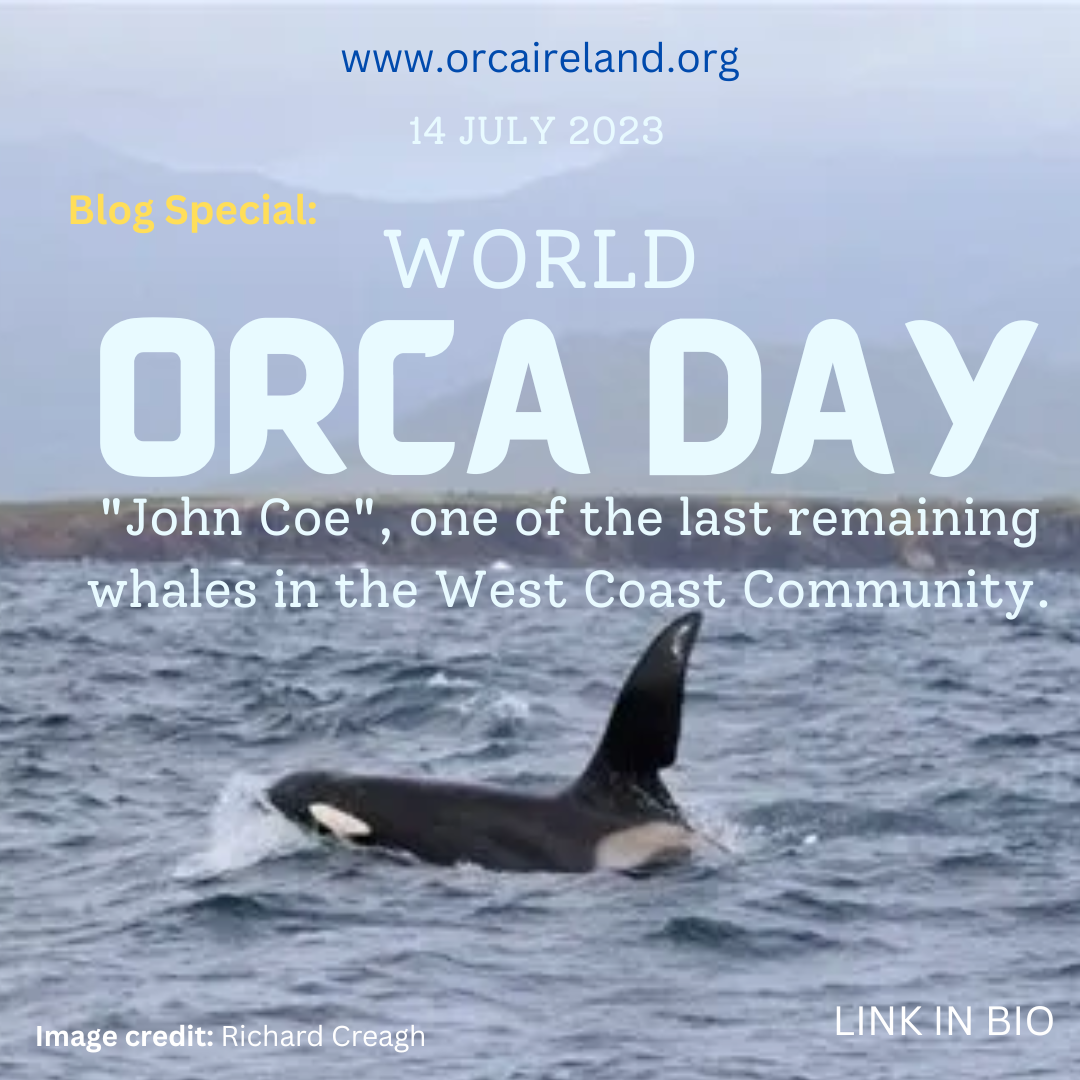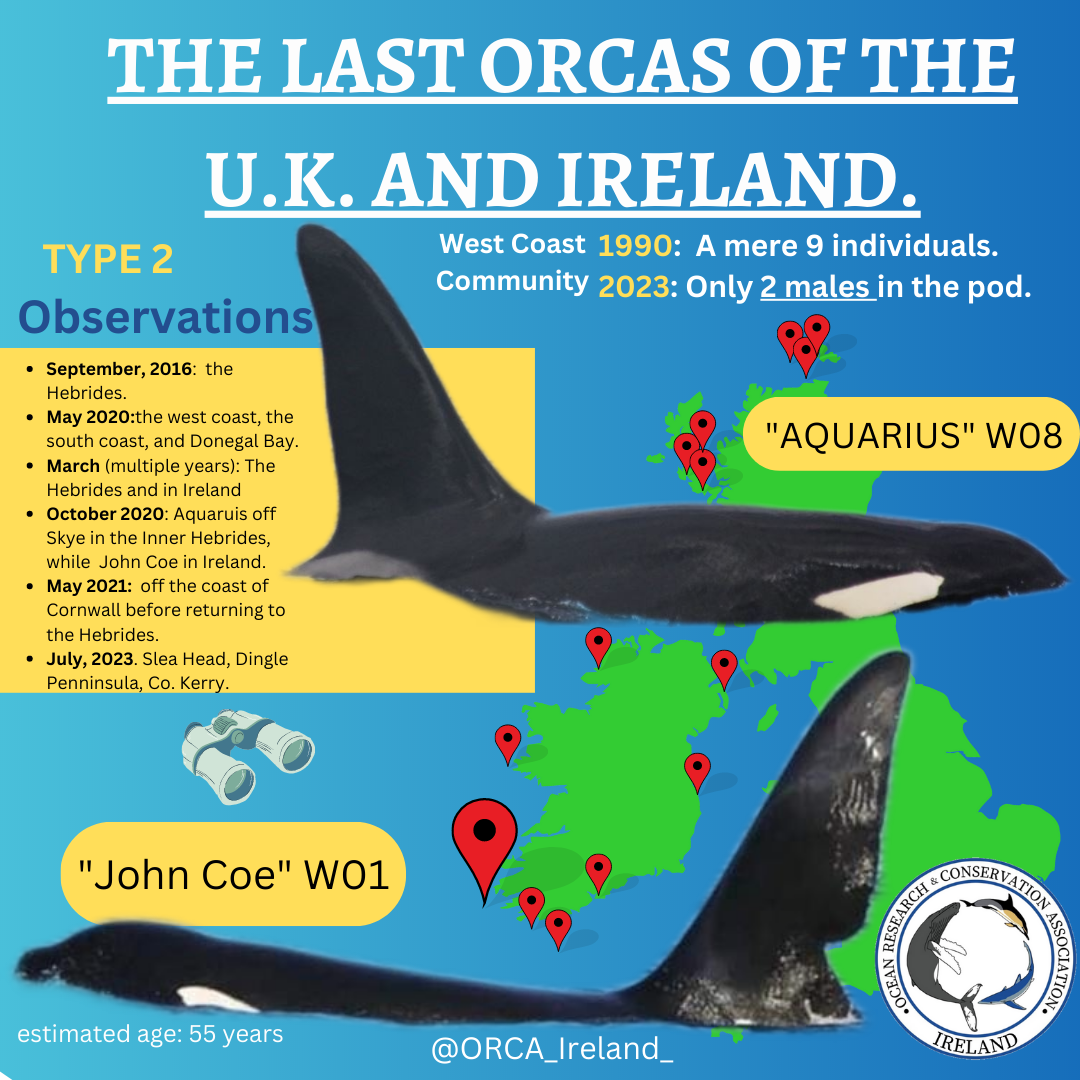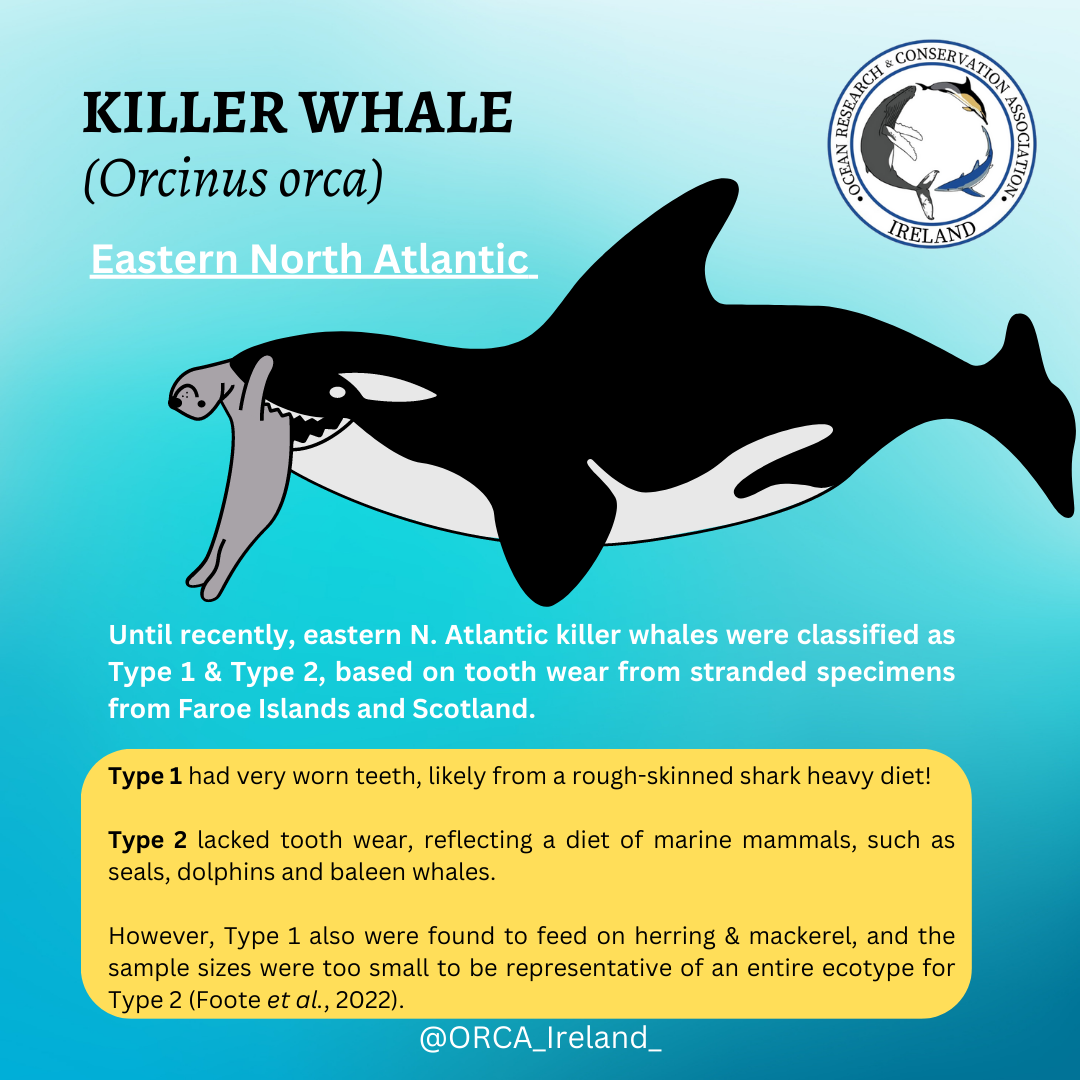The Last Orcas of Ireland and the U.K.
WORLD ORCA DAY
The Last Orcas of Ireland and the U.K.
Emer Keaveney I July 14th, 2023
The Scottish West Coast Community of killer whales (Orcinus orca), are a distinct pod of orcas that have been visiting the Irish coast for years. Among them are two orcas, "John Coe" and "Aquarius", the last remaining members of the pod of resident orcas in the U.K.
For WORLD ORCA DAY 2023, we want to share what we know and raise awareness about this critically endangered group of killer whales and their annual visit to Irish waters.

Who are John Coe and Aquarius?
"John Coe" - W01 and "Aquarius" - W08, are the last two remaining orcas from the Scottish West Coast Community of killer whales. They are both males, and are known for their distinctive dorsal fins which can reach 1.8 meters or, 6ft tall. The pair have been spotted all around the Irish coast over the years, including in the Irish Sea, the west coast, the south coast, and Donegal Bay.
The West Coast Community of Killer Whales:
The West Coast Community of killer whales is a small, critically endangered population of orcas primarily found in the waters surrounding mainland Scotland and the Hebrides. The population was first observed in the 1980s, and at that time, there were thought to be around twenty unique individuals within the population. The West Coast Community of killer whales is a genetically distinct group within the larger population of killer whales that are found in the waters around Scotland and Ireland. Genetic studies have been conducted using nuclear microsatellite loci and mitochondrial DNA sequences to examine population subdivisions.
The West Coast Community are known for their distinctive vocalizations and are one of the most studied orca populations in the world. In 1992, the community was made up of around nine individuals. As of 2023, only two individuals, W001 "John Coe" and W008 "Aquarius," remain from the West Coast Community.
Annual Visit to Irish Waters:
"John Coe" and "Aquarius" have been visiting Irish waters for years, and their annual visit is eagerly anticipated by whale watchers and marine enthusiasts. They are usually spotted off the coast of Ireland in the summer months May - July, and their presence is a reminder of the importance of protecting our marine ecosystems and the creatures that call them home.
.
Where have they been seen?
Here are some locations and dates of sightings of "John Coe" and "Aquarius" over the years:
- September 21, 2016: John Coe and Aquarius were sighted in the Hebrides.
- May 15, 2020: John Coe and Aquarius were sighted in the Irish Sea, the west coast, the south coast, and Donegal Bay.
- March (multiple years): The pair have been spotted in the Hebrides around the same time in March for the last few years, with sightings often reported in Ireland.
- October 2020: The last confirmed sighting of the pair was reported off Skye in the Inner Hebrides, while in Ireland, John Coe was last seen.
- May 2021: John Coe and Aquarius were sighted off the coast of Cornwall before returning to the Hebrides.
- July 2023: Slea Head, Dingle Penninsula, Co. Kerry.

Conservation Threats:
"According to the Hebridean Whale and Dolphin Trust, there are only two remaining members of the West Coast Community of killer whales, John Coe and Aquarius, as of 2023."
The West Coast Community of killer whales is facing an uncertain future, and the impending doom of John Coe and Aquarius is a stark reminder of the need for urgent action to protect our oceans. The population is at risk of extinction due to a combination of factors, including pollution, climate change, and overfishing.
The West Coast Community of killer whales is a critically endangered population, and their numbers have dwindled over the years due to a combination of factors, including pollution, climate change, and overfishing. The main factors contributing to the decline of the West Coast Community of killer whales include:
- Reduced Prey Availability: The ongoing decline of the Southern Resident killer whale population over the last 20 years is most likely due to decreased quantity and quality of prey. The West Coast Community of killer whales is also facing a similar issue, with a reduction in prey availability affecting their survival.
- Chemical Contaminants: Persistent organic pollutants (POPs) are a significant threat to the Southern Resident killer whale population, and they are also present in the waters around Scotland and Ireland. These contaminants can accumulate in the tissues of marine mammals, leading to reproductive and immune system problems.
- Disturbance from Vessel Traffic and Noise Pollution: The presence of vessel traffic and noise pollution can disrupt the behavior and communication of killer whales. The West Coast Community of killer whales is particularly vulnerable to this threat, as they are a small population that relies heavily on vocalizations for communication.
- Overfishing: Overfishing can reduce the availability of prey for killer whales, and it can also lead to the depletion of fish stocks. This can have a cascading effect on the entire marine ecosystem, affecting the survival of many species, including killer whales.
- Climate Change: Climate change can affect the distribution and abundance of prey species, leading to changes in the feeding behavior of killer whales. It can also lead to changes in ocean currents and temperatures, which can have a significant impact on marine ecosystems.
Dietary Preferences
Killer whales in general are known to have diverse diets, including fish, marine mammals, and cephalopods. The West Coast Community of killer whales primarily feeds on other cetaceans and harbor seals. It is important to note that the diet of the West Coast Community of killer whales may vary depending on the availability of prey in their habitat. The diet of killer whales in different regions can also vary, with some populations feeding on herring and other schooling fish, while others eat stingrays and sharks. It is important to note that killer whale populations can have different feeding strategies and prey preferences based on their geographic location and ecological factors. The availability of prey species in their respective habitats plays a significant role in shaping their diets. For example, diets of killer whales from the North Pacific Ocean include:
- Resident Killer Whales (U.S. Pacific Northwest):Diet: Fish, mainly salmon.
- Ecotypes: Residents are known to exclusively eat fish, primarily salmon.
- Transients or Bigg's killer whales primarily eat marine mammals and squid.
- Southern Resident Killer Whales (Eastern North Pacific):Diet: Fish, mainly salmon.
- Population: Three populations of Resident killer whales in the eastern North Pacific.
.
- Recent Reproduction: Variable number of offspring in recent years, with a low number of births recorded from 2012 to 2014.
The diet of different populations of killer whales can have an impact on their social structure. For example;
Resident Killer Whales (British Columbia and Washington):
- Main Diet: Fish, mainly salmon.
- Social Structure: Resident killer whales in this region have a matrilineal social structure, where the bonds between family members are extremely strong and stable.
- The matriline can consist of only one generation to as many as four generations of related whales.
Transient Killer Whales (British Columbia and Washington):
- Main Diet: Marine mammals, such as seals and sea lions, and occasionally other cetaceans.
- Social Structure: Transient killer whales are known to travel in small groups of two to six individuals, often consisting of a mother and her offspring.
North Atlantic Killer Whales:
- Main Diet: Varies by region and individual. In some areas, killer whales prefer to consume other whales, such as belugas, narwhals, baleen whales, and porpoises.
- .Social Structure: The social structure of North Atlantic killer whales is not well-documented. However, like other killer whale populations, they are known to travel in family groups.

Southern Resident Killer Whales (Eastern North Pacific):
- Main Diet: Fish, mainly salmon, with steelhead being a prominent prey species.
- Social Structure: Southern Resident killer whales have a matrilineal social structure, where the bonds between family members are extremely strong and stable. The matriline can consist of only one generation to as many as four generations of related whales.
These differences in social structure reflect the adaptability of killer whales to their specific environments and prey availability. The social structure of killer whale populations can be influenced by factors such as the size and nature of the group, the strength of the bonds between family members, and the stability of the group over time.
SHARE THIS ARTICLE













